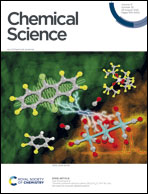Mutual functionalization of dinitrogen and methane mediated by heteronuclear metal cluster anions CoTaC2−†
Abstract
The direct coupling of dinitrogen (N2) and methane (CH4) to construct the N–C bond is a fascinating but challenging approach for the energy-saving synthesis of N-containing organic compounds. Herein we identified a likely reaction pathway for N–C coupling from N2 and CH4 mediated by heteronuclear metal cluster anions CoTaC2−, which starts with the dissociative adsorption of N2 on CoTaC2− to generate a Taδ+–Ntδ− (terminal-nitrogen) Lewis acid–base pair (LABP), followed by the further activation of CH4 by CoTaC2N2− to construct the N–C bond. The N![[triple bond, length as m-dash]](https://www.rsc.org/images/entities/char_e002.gif) N cleavage by CoTaC2− affording two N atoms with strong charge buffering ability plays a key part, which facilitates the H3C–H cleavage via the LABP mechanism and the N–C formation via a CH3 migration mechanism. A novel Nt triggering strategy to couple N2 and CH4 molecules using metal clusters was accordingly proposed, which provides a new idea for the direct synthesis of N-containing compounds.
N cleavage by CoTaC2− affording two N atoms with strong charge buffering ability plays a key part, which facilitates the H3C–H cleavage via the LABP mechanism and the N–C formation via a CH3 migration mechanism. A novel Nt triggering strategy to couple N2 and CH4 molecules using metal clusters was accordingly proposed, which provides a new idea for the direct synthesis of N-containing compounds.



 Please wait while we load your content...
Please wait while we load your content...